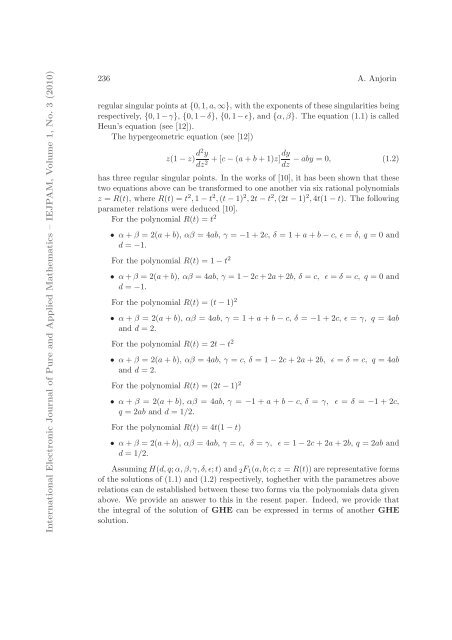In te rn a tio n a l E le ctro n ic J o u rn a l o f P u re a n d A p p lie d M ...
In te rn a tio n a l E le ctro n ic J o u rn a l o f P u re a n d A p p lie d M ...
In te rn a tio n a l E le ctro n ic J o u rn a l o f P u re a n d A p p lie d M ...
Create successful ePaper yourself
Turn your PDF publications into a flip-book with our unique Google optimized e-Paper software.
<strong>In</strong><strong>te</strong><strong>rn</strong>a<strong>tio</strong>nal E<strong>le</strong><strong>ctro</strong>n<strong>ic</strong> Jou<strong>rn</strong>al of Pu<strong>re</strong> and App<strong>lie</strong>d Mathemat<strong>ic</strong>s – IEJPAM, Volume 1, No. 3 (2010)<br />
236 A. Anjorin<br />
<strong>re</strong>gular singular points at {0,1,a, ∞}, with the exponents of these singularities being<br />
<strong>re</strong>spectively, {0,1 −γ}, {0,1 −δ}, {0,1 −ǫ}, and {α,β}. The equa<strong>tio</strong>n (1.1) is cal<strong>le</strong>d<br />
Heun’s equa<strong>tio</strong>n (see [12]).<br />
The hypergeometr<strong>ic</strong> equa<strong>tio</strong>n (see [12])<br />
z(1 − z) d2y + [c − (a + b + 1)z]dy − aby = 0, (1.2)<br />
dz2 dz<br />
has th<strong>re</strong>e <strong>re</strong>gular singular points. <strong>In</strong> the works of [10], it has been shown that these<br />
two equa<strong>tio</strong>ns above can be transformed to one another via six ra<strong>tio</strong>nal polynomials<br />
z = R(t), whe<strong>re</strong> R(t) = t 2 ,1 − t 2 ,(t − 1) 2 ,2t − t 2 ,(2t − 1) 2 ,4t(1 − t). The following<br />
parame<strong>te</strong>r <strong>re</strong>la<strong>tio</strong>ns we<strong>re</strong> deduced [10].<br />
For the polynomial R(t) = t 2<br />
• α + β = 2(a + b), αβ = 4ab, γ = −1 + 2c, δ = 1 + a + b − c, ǫ = δ, q = 0 and<br />
d = −1.<br />
For the polynomial R(t) = 1 − t 2<br />
• α + β = 2(a + b), αβ = 4ab, γ = 1 − 2c + 2a + 2b, δ = c, ǫ = δ = c, q = 0 and<br />
d = −1.<br />
For the polynomial R(t) = (t − 1) 2<br />
• α + β = 2(a + b), αβ = 4ab, γ = 1 + a + b − c, δ = −1 + 2c, ǫ = γ, q = 4ab<br />
and d = 2.<br />
For the polynomial R(t) = 2t − t 2<br />
• α + β = 2(a + b), αβ = 4ab, γ = c, δ = 1 − 2c + 2a + 2b, ǫ = δ = c, q = 4ab<br />
and d = 2.<br />
For the polynomial R(t) = (2t − 1) 2<br />
• α + β = 2(a + b), αβ = 4ab, γ = −1 + a + b − c, δ = γ, ǫ = δ = −1 + 2c,<br />
q = 2ab and d = 1/2.<br />
For the polynomial R(t) = 4t(1 − t)<br />
• α + β = 2(a + b), αβ = 4ab, γ = c, δ = γ, ǫ = 1 − 2c + 2a + 2b, q = 2ab and<br />
d = 1/2.<br />
Assuming H(d,q;α,β,γ,δ,ǫ;t) and 2F1(a,b;c;z = R(t)) a<strong>re</strong> <strong>re</strong>p<strong>re</strong>sentative forms<br />
of the solu<strong>tio</strong>ns of (1.1) and (1.2) <strong>re</strong>spectively, toghether with the paramet<strong>re</strong>s above<br />
<strong>re</strong>la<strong>tio</strong>ns can de established between these two forms via the polynomials data given<br />
above. We provide an answer to this in the <strong>re</strong>sent paper. <strong>In</strong>deed, we provide that<br />
the in<strong>te</strong>gral of the solu<strong>tio</strong>n of GHE can be exp<strong>re</strong>ssed in <strong>te</strong>rms of another GHE<br />
solu<strong>tio</strong>n.


